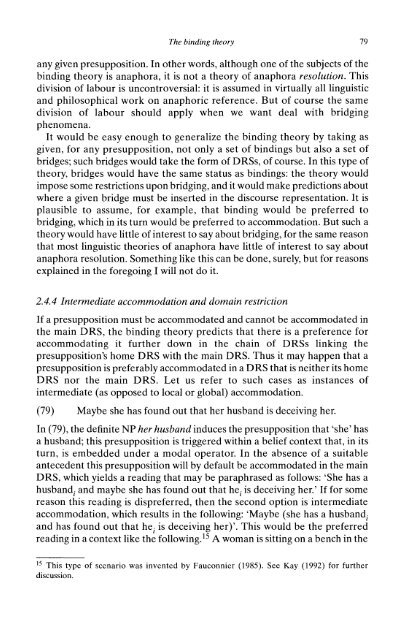Presuppositions and Pronouns - Nijmegen Centre for Semantics
Presuppositions and Pronouns - Nijmegen Centre for Semantics
Presuppositions and Pronouns - Nijmegen Centre for Semantics
You also want an ePaper? Increase the reach of your titles
YUMPU automatically turns print PDFs into web optimized ePapers that Google loves.
The binding theory 79<br />
any given presupposition. In other words, although one of the subjects of the<br />
binding theory is anaphora, it is not a theory of anaphora resolution. This<br />
division of labour is uncontroversial: it is assumed in virtually all linguistic<br />
<strong>and</strong> philosophical work on anaphoric reference. But of course the same<br />
division of labour should apply when we want deal with bridging<br />
phenomena.<br />
It would be easy enough to generalize the binding theory by taking as<br />
given, <strong>for</strong> any presupposition, not only a set of bindings but also a set of<br />
bridges; such bridges would take the <strong>for</strong>m of DRSs, of course. In this type of<br />
theory, bridges would have the same status as bindings: the theory would<br />
impose some restrictions upon bridging, <strong>and</strong> it would make predictions about<br />
where a given bridge must be inserted in the discourse representation. It is<br />
plausible to assume, <strong>for</strong> example, that binding would be preferred to<br />
bridging, which in its turn would be preferred to accommodation. But such a<br />
theory would have little of interest to say about bridging, <strong>for</strong> the same reason<br />
that most linguistic theories of anaphora have little of interest to say about<br />
anaphora resolution. Something like this can be done, surely, but <strong>for</strong> reasons<br />
explained in the <strong>for</strong>egoing I will not do it.<br />
2.4.4 Intermediate accommodation <strong>and</strong> domain restriction<br />
If a presupposition must be accommodated <strong>and</strong> cannot be accommodated in<br />
the main DRS, the binding theory predicts that there is a preference <strong>for</strong><br />
accommodating it further down in the chain of DRSs linking the<br />
presupposition's home DRS with the main DRS. Thus it may happen that a<br />
presupposition is preferably accommodated in a DRS that is neither its home<br />
DRS nor the main DRS. Let us refer to such cases as instances of<br />
intermediate (as opposed to local or global) accommodation.<br />
(79) Maybe she has found out that her husb<strong>and</strong> is deceiving her.<br />
In (79), the definite NP her husb<strong>and</strong> induces the presupposition that 'she' has<br />
a husb<strong>and</strong>; this presupposition is triggered within a belief context that, in its<br />
turn, is embedded under a modal operator. In the absence of a suitable<br />
antecedent this presupposition will by default be accommodated in the main<br />
DRS, which yields a reading that may be paraphrased as follows: 'She has a<br />
husb<strong>and</strong>, i<br />
<strong>and</strong> maybe she has found out that he i<br />
is deceiving her.' If <strong>for</strong> some<br />
reason this reading is dispreferred, then the second option is intermediate<br />
accommodation, which results in the following: 'Maybe (she has a husb<strong>and</strong>; i<br />
<strong>and</strong> has found out that he- i<br />
is deceiving her),. her)'. This would be the preferred<br />
reading in a context like the following. 15 A woman is sitting on a bench in the<br />
15 15 This type of scenario was invented by Fauconnier (1985). See Kay (1992) <strong>for</strong> further<br />
discussion.














